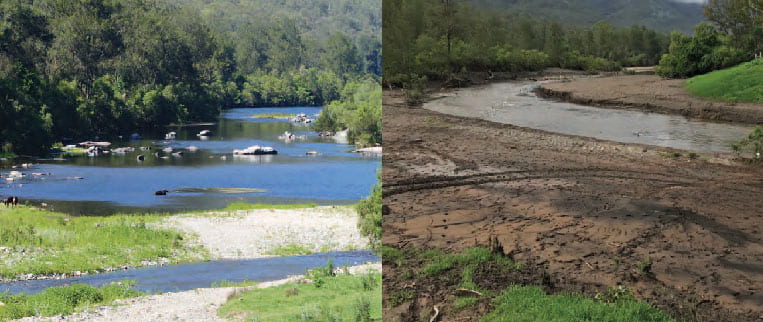Drought and bushfires have impacted our coastal catchments in NSW, the plants and animals that they support, and the ecosystem services they provide for most of NSW’s population who live in them. Collaborative interdisciplinary science that informs government policy and engages the community is one of the best tools we have to protect these valuable ecosystems.
— Dr Sarah Mika, School of Environmental and Rural Science
Coastal rivers and estuaries are ecologically, socially and economically valuable. These ecosystems support many birds and animals. In northern New South Wales, a region extending 50,000km2 from the Queensland border, south to the Camden Haven River and inland to the New England Tablelands, the extensive coastal river systems form a National Biodiversity Hotspot, as the third most biodiverse region in Australia. This region is home to 380 species, 5 populations and 13 communities listed as endangered or vulnerable under the NSW Threatened Species Conservation Act 1995, two World Heritage Areas, a Ramsar-listed Wetland and 25 wetlands listed on the Directory of Nationally Important Wetlands.
Australia’s human population is also concentrated on the eastern seaboard. Human land use and urbanisation in these catchments results in a complex array of interacting pressures and stressors threatening the ecological condition of many of these freshwater and estuarine ecosystems. One of the most pervasive threats to aquatic ecosystems comes from terrestrial non-point source pollutants, recognised globally as one of the leading causes of poor water quality. Non-point source pollutants include fine-grained sediments from improperly managed crop and forest lands, unsealed roads, construction sites and eroding streambanks; excessive nitrogen and phosphorus (nutrients) from fertiliser runoff; oil, grease and contaminants from urban stormwater; acid and heavy metal drainage from abandoned mines; salts from irrigated crops and pastures; and bacteria and nutrients from livestock production and leaking septic systems.
Dr Sarah Mika is a Senior Research Fellow and leads the coastal rivers and estuaries research program for UNE’s Aquatic Ecology Lab. It is one of the few research labs that work across the freshwater-estuarine gradient. This allows an interdisciplinary approach to studying catchment-scale impacts on rivers and estuaries, which is critical when tackling the wicked problem of non-point source pollution.
These are very difficult threats to manage, because they occur over a large scale and individual sources of these pollutants change in time. As fine-grained sediments enter rivers and estuaries, they bring with them nutrients and contaminants that attach onto the sediment grains. The sediment itself increases the turbidity of the water, reducing the feeding efficiency of invertebrate filter-feeders such as mussels in freshwater, and oysters in the estuary, as well as visual predators such as fish and wading birds. Turbidity also reduces the ability of aquatic plants to photosynthesise, reducing their health and biomass. Dr Mika’s research is helping state and local government agencies identify key issues within coastal catchments and prioritise their investment in catchment and streambank remediation. In particular, Dr Mika has been working with Hornsby Shire Council, Port Macquarie-Hastings Council, Kempsey Shire Council, Nambucca Valley Council, Bellingen Shire Council, Coffs Harbour City Council, Clarence Valley Council, Glen Innes Severn Council, Kyogle Council, Lismore City Council and Ballina Shire Council, the North Coast and Northern Tablelands Local Land Services, and the NSW Department of Planning, Industry and Environment over the last 7 years, to reduce nutrient and fine sediment pollution in these coastal rivers and estuaries.
Many of Australia’s coastal rivers were adapted to low concentrations of the three key nutrients of nitrogen, phosphorus and carbon. Eutrophication is the increase in concentrations of nitrogen and/or phosphorus above these naturally low levels, leading to excessive plant and algal growth. In estuaries, algae attach to seagrass which is an important habitat for fish. Excessive algal growth reduces the light penetration and photosynthetic ability of the seagrass itself, starving it of food resources. Large areas of seagrass have been lost in many NSW estuaries, in part due to eutrophication. Some of the nuisance algae species include toxic blue-green algae (cyanobacteria), and these blooms result in closures of fisheries and recreational use of the estuary. When the algae die, they are readily consumed by microbes that, in turn consume the oxygen dissolved in the water column, leading to hypoxic or anoxic dead zones that can kill many fish and invertebrate species.
Ecological stoichiometry is a unifying framework that links the relative supply of elements including key nutrients to the structure and function of food webs. This lets us trace the impacts of land use through aquatic systems, by combining hydrological, biogeochemical and ecological research. We can follow the rates and types of multiple nutrients, through their regulation of the quantity and quality of primary producers such as plants and algae, to bacteria and microbes, freshwater and estuarine zooplankton, macroinvertebrates and then through to small and large fish. It also allows us to assess the effects of different types of disturbances on aquatic ecosystems. For example, we are testing how predicted increases in atmospheric carbon dioxide (CO2) and temperature with climate change will change the ratio of carbon, nitrogen and phosphorus in terrestrial streambank plants and dissolved within the water column, and how that changes the composition, abundance and nutritional quality of primary producers and consumers through aquatic food webs.
Dr Mika and her lab colleagues are also working with local and state government agencies to examine the impacts of the extensive bushfires in northern NSW on rivers and estuaries. When it rains after a bushfire, sediment runoff is increased, and increased nutrients enter the rivers and estuaries from ash and burnt vegetation. This will lead to increased nutrients and changes to aquatic food webs over a long timeframe, and can lead to sudden changes such as fish kills when microbes consume all the oxygen in the water column while eating the organic matter washed in.
[Banner photo courtesy of Sara Mika.]



